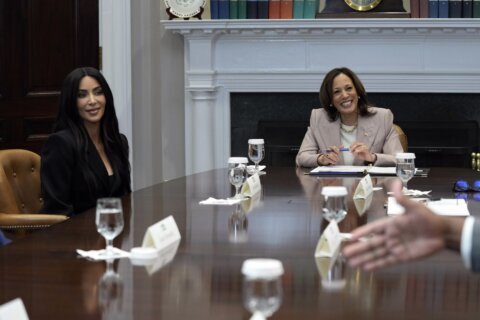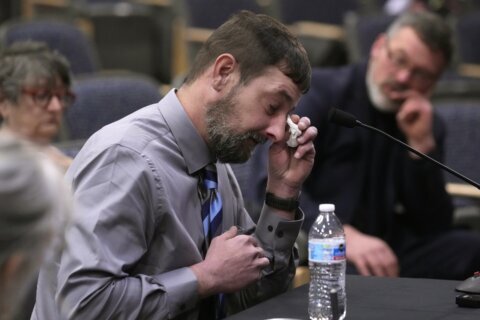WASHINGTON — Nearly one in four members of the military in a recent poll said they had seen demonstrations of white nationalism among fellow troops, and a reporter on the military and a longtime observer of hate groups both say the armed forces aren’t immune to the problems of the rest of society.
The Military Times poll of 1,131 active-duty service members had perhaps an even more eye-popping result: Around 30 percent of the troops surveyed said they considered white nationalism a significant danger to national security. That’s more than who said the same of Syria, Pakistan, Afghanistan or Iraq.
Leo Shane III, who wrote about the poll for Military Times, said the results stand in contrast to the image a lot of people have of the armed forces.
“People have a vision of the military — it doesn’t matter whether you’re black or white or Hispanic,” Shane told WTOP; “you go in, you do your job, you serve admirably, you advance …. This shows that the military is the same as our society: There are divisions; there are problems in there that all the training and the higher ideals can’t erase.”
The poll was taken in the wake of the white nationalist rally in Charlottesville, Virginia, in August, which resulted in the death of a counter-protester. One of the white nationalist groups, Vanguard America, is led by a Marine veteran who served for 11 years, including in Iraq and Afghanistan, and left the service in January.
James Fields, who has been charged in the death of Heather Heyer, was pictured marching with the group, although the group denies he’s a member.
After Charlottesville, military leaders made strong statements against white nationalism:
- Marine Corps Commandant Robert B. Neller said, “Our core values of honor, courage and commitment frame the way Marines live and act. Bigotry and racial extremism run contrary to these core values.”
- Admiral John Richardson, the chief of naval operations, said that “The Navy will forever stand against intolerance and hatred.”
- Army chief of staff Gen. Mark Milley said, “The Army doesn’t tolerate racism, extremism, or hatred in our ranks. It’s against our Values and everything we’ve stood for since 1775.”
- And after racist graffiti was written at the Air Force Academy’s preparatory school in September, a visibly angry Superintendent Lt. Gen. Jay Silveria told cadets, “If you can’t treat someone from another race, or different color skin, with dignity and respect, then you need to get out” — and invited cadets to pull out their phones and record him saying it.
The Military Times poll found, however, that examples of white nationalism were experienced by 42 percent of nonwhite military members; among white troops, the number was 18 percent. As high-profile white nationalist gatherings increase across the country, Shane said, the military seems to be reflecting that.
“As much as the military likes to see itself as a melting pot and [use slogans such as] ‘One Team, One Fight,’” Shane said, “there are still the same problems that are elsewhere in society.”
‘A long-standing and serious problem’
Heidi Beirich, leader of The Intelligence Project of the Southern Poverty Law Center, said of white nationalism in the military, “I’m unfortunately not surprised to hear that this is the case. … This is a long-standing and serious problem.”
She said her group has been “badgering” the Department of Defense on the issue, influencing the crafting of rules, since the 1980s, when they persuaded Caspar Weinberger to ban “card-carrying hate-group members from the military.”
Beirich said the gate between white nationalists and the military swings in both directions.
Such groups recruit members of the military while they’re in the service, Beirich said, pointing to the discovery in the 1990s of recruiting material for the neo-Nazi National Alliance in a barrack at Camp LeJeune, in North Carolina; they also prize landing newly discharged veterans as members of their groups, looking to capitalize on their military skills.
The neo-Nazi National Alliance, of which Oklahoma City bomber Timothy McVeigh was once a member, “had an actual military coordinator,” Beirich said. Most hate groups, she said, “have these fantasies about race wars, or fighting for the rights of white people, or revolutionary ideas. So that skill set that you get, even through a basic tour in the military, is one that puts you in a good position for achieving these fanatical goals.”
In a 2008 report, the FBI found that the number of military personnel or veterans in white-supremacist groups made up a very small percentage of the movement, “the prestige which the extremist movement bestows upon members with military experience grants them the potential for influence beyond their numbers.”
They added that “most extremist groups have some members with military experience,” and that those with military experience were often elevated to leadership positions. “Extremist leaders seek to recruit members with military experience in order to exploit their discipline, knowledge of firearms, explosives, and tactical skills and access to weapons and intelligence.”
‘Just a media invention’
Shane said that some of the respondents to the Military Times poll pushed back against the question. “We got quite a few comments back from folks who accused us of making up the problem, saying ‘White nationalism isn’t a real thing,’ ‘This is just a media invention.’ And quite a few people said ‘White nationalism doesn’t mean racism. This isn’t an issue; it’s just some people’s views, and we should let it go.’”
He said that seeing such comments intermixed with such a strong report of white nationalism “just reinforces that this is a presence in the military.” A sizable number of respondents also complained that the survey didn’t include groups such as Black Lives Matter as a possible threat to national security; Shane said the desire “to equate the two speaks to how some people feel about white nationalism. It’s shocking to see that.”
Beirich had a few suggestions for the military. First off, when evidence of white nationalism is found, “[It’s] got to be dealt with immediately, swiftly and harshly.” Second, they should partner with groups such as hers, as well as the Anti-Defamation League, to share information and make sure they and outside observers are on the same page. “We have some relationships with certain branches of the military, and not with others,” Beirich said.
And military branches need to make sure their extant policies are being enforced: “They have to look at who they’re recruiting and how they’re recruiting.”
‘We’ve had a long history of this’
It would seem that the lack of self-segregation in the military would work against racism and white nationalism, but Beirich said many hate groups are in heavily minority areas. Echoing Shane’s point, Beirich said that the presence of white nationalism in such opposition to the training and traditions of the military is a more sobering sign of its virulence and durability. “The military is inculcating multicultural, anti-racist values in all its folks, and [you’d think] that that would serve as a barrier to developing white nationalist ideas. But as I’ve said, we had a long history of this.”
The military was desegregated in the 1940s, but in the 1980s the SPLC was still finding “lots and lots of card-carrying members of hate groups — these are people carrying around Ku Klux Klan cards,” Beirich said. “The problem keeps morphing because there’s racism in our society and it also shows up there. And it’s a bit of a battle to push it back.”








